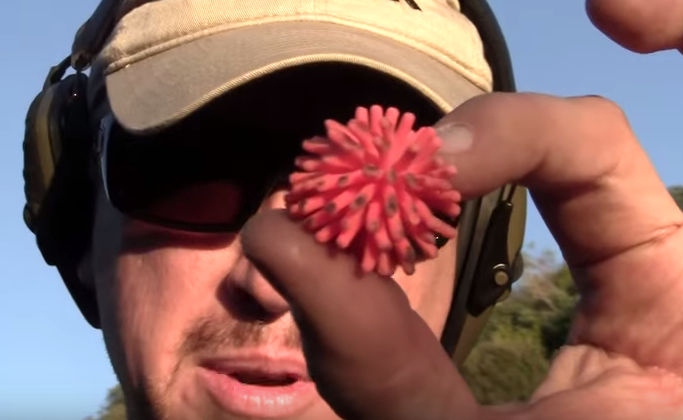
No Buzz Killin
A YouTube host displays one of the Star-Lite rounds manufactured by Lightfield Ammunition.
Editor’s note: On July 13, City Limits published a story about a Department of Correction training program involving the use of shotgun-propelled “less than lethal” ammunition. Published articles on that program had described the guns involved as “pellet-firing.” Our article mentioned problems that have occurred elsewhere with pellet-firing firearms and with the use of other shotgun-propelled projectiles in a correctional setting. Because of an editing error, our article suggested that the weapons being used in NYC DOC training were the same as in those other places. As the revised article below indicates, a different sort of projectile is what New York jail officials are contemplating deploying in a very limited fashion. But as we note below, any weapon involves tradeoffs and less-than-lethal ones are no different.
* * * *
Early in the 1980 Steve McQueen movie “The Hunter,” McQueen’s character, bail agent Papa Thorson, sets out to nab a mountainously built fugitive named Billie Joe. Having tracked the man down and driven to his cabin, Thorson opens his trunk to prepare for a violent encounter. However, he leaves behind the firearms stowed there in favor of a strange looking, wide-barrelled instrument. As Thorson walks toward the confrontation, LeVar Burton’s character asks him what that odd thing is. “It’s a stun gun,” Thorson replies. What does it do, he’s asked. “It ruins your day.”
McQueen was packing the original “stun gun,” which had been in circulation for about a decade and fired a half-pound “bean bag” that was filled with lead shot. “The blow is hard enough to stun or incapacitate a person,” wrote The New York Times in 1970. “But, because the impact is distributed over an area the size of the flexible bag, the police say it is not hard enough to kill or inflict serious injury except in a freak case.”
Since then, law enforcement agencies—and the weapons companies that supply them—have pursued more advanced ways to stop a suspect or control a riot without using lethal force (i.e., bullets). This year the city’s Department of Correction has entered into a contract to train its Emergency Services Units, which respond to major emergencies in the city’s jails, in the use of the Kel-Tec tactical shotgun to fire Star-Lite projectiles. The Star-Lite is a small, spongy, multipronged rubber star that its manifacturer, Lightfield Ammunition, calls “a close-range less-lethal impact projectile.”
The DOC stresses that the department owns no Kel-Tec shotguns or Star-Lite rounds and has no plans to purchase or deploy them at this time; the $1.2 million contract with U.S. Correction-Special Operations Group covers seven different tactical technologies and its chief purpose is to discern whether any of them should become part of DOC’s toolkit. The Daily News has reported that one of the seven options, the Taser conducted electrical weapon, is closer to being part of the DOC arsenal than the other technology under consideration.
According to a copy of the contract obtained via Freedom of Information Act, the training also includes training in “close quarters riot control,” “dynamic cell extraction,” hostage responses, “high-risk security patrols,” and “tactical chemical agents.”
At this time, most COs only carry cans of OC spray, also known as “pepper” spray. ESU officers may have other equipment, like polycarbon shields. The training covered by the contract does not involve most of DOC’s 9,500 correction officers: Only the 198 people in the ESU are taking part.
Aimed at reducing violence
News of the USC-SOG contract comes as city jail officials continue to deal with the fallout from investigations into widespread abuse of inmates on Rikers Island and rising violence in the city’s jails. Rates of inmate-on-inmate assaults, serious injuries from those inmate fights and inmate assaults on correction officers have soared over the past two years.
The evaluation of possible new weapons is part of a larger rethink of how to use the ESU. ESU personnel have traditionally been based at a central location. Now they might be stationed in smaller teams at the different Rikers jails to allowe faster response to incidents and better awareness of how each facility operates.
If adopted, only the ESU officers would use the Kel-Tec “launcher.” In the case of the Taser, DOC is only considering providing it to the 32 captains who lead ESU teams. The purpose of investigating the possible use of these less-than-lethal weapons, the department says, is to reduce the need for more brutal forms of force (like batons or fists) in responding to a violent incident.
“DOC is considering allowing a small group of captains involved in cell extractions and other security operations to carry low-voltage Tasers in order to minimize confrontations and physical injuries to staff and inmates,” a DOC spokesperson said in a statement. “Research on Tasers around the country has shown that their use is associated with reductions in injuries to officers and citizens.”
DOC notes that its new use of force policy “emphasizes de-escalation and defensive techniques” and that’s why it is “modernizing the training of its Emergency Services Unit.” DOC credits that training with a 53 percent reduction in serious uses of force so far this year.
While DOC does own Tasers, they are still not being used. The agency says it would consult with the Board of Correction, the federal monitor overseeing jails under the settlement with the U.S. attorney’s office, and others before moving to introduce any weapons, although the Board doesn’t have statutory authority over officer training.
“[The Tasers] would enable our captains to de-escalate incidents even more safely,” the spokesperson adds. DOC points to stats showing a reduction in injuries to suspects after Tasers are introduced.
Tasers and Star-Lite rounds serve different purposes because they are used at different distances, according to weapons expert Sid Heal, a former LAPD commander who has taught non-lethal weaponry at all the U.S. war colleges. Tasers are effective from 12 to 18 feet away from the target, while shotgun-fired rubber Star-Lite spiders can be shot from 25 to 30 yards away, though the manufacturer says the ideal range is 1 to 10 yards.
A question of tradeoffs
The federal Bureau of Prisons already makes use of this class of weapons. “The Bureau authorizes the use of less than lethal munitions in emergency situations,” BOP’s public affairs office tells City Limits. “The warden or their designee may authorize the use of less-lethal equipment based on a determination that a delay in bringing the situation under control would pose a danger to inmates, staff, or the public or result in a major disturbance or serious property damage.” BOP did not specify what kinds of less-lethal devices it has.
New York’s state prison system does not deploy such weapons inside its correctional facilities; it’s unclear whether the Department of Correction and Community Supervision possesses those types of weapons at other locations for emergency use.
Some correctional systems don’t bother with the less-than-lethal stuff at all. At some Nevada prisons, a Huffington Post investigation found, guards made a habit of firing real shotgun shells—filled with metal particles designed to kill—at inmates. The results were horrifying.
What the city’s jail system is considering is totally different. But that doesn’t mean it couldn’t be problematic.
It wasn’t long after the introduction of the Stun-Gun in 1970 that law enforcement agencies learned “less-than-lethal” doesn’t mean harmless—and that using such a weapon doesn’t always avoid a person’s death. As early as 1974, military researches reported, “Stun-bag impacts seem to produce a ‘liver phenomenon,’ i.e. unexpected damage to the liver even from low-energy shots impacting body areas remote from the liver.”
In settings elsewhere, less-than-lethal munitions have stoked controversy because of injuries they cause. Amnesty International has called for Indian security forces in the state of Jammu and Kashmir to stop using pellet-firing shotguns because they frequently cause eye injuries. Israeli Defense Forces’ use of rubber bullets has also been criticized.
The weapons DOC is considering—Tasers and, further down the road if at all, Star-Lite rounds–are very different from what the Israelis or Indians are using, but neither is risk free. A 2011 National Institute of Justice study found that “multiple or prolonged activations of [conducted electrical devices] as a means to accomplish subdual should be minimized or avoided.” The manufacturer of Star-Lite, meanwhile, warns: “The user should only target large muscle groups and soft tissue from the abdomen and below. Always avoid targeting the head, neck, thorax, spine, kidney area and groin as serious injury or death may occur.”
There’s also the concern that, precisely because they are less lethal, officers will overuse those weapons. “Some officers may turn to a [Taser] too early in an encounter and may rely on [it] rather than on their conflict resolution skills or even on hands-on applications,” the National Institutes of Justice wrote in 2010.
The Correction Department says the configuration of Tasers it is considering avoids the problems highlighted by the NIJ.
Heal, who serves as president of the California Association of Tactical Officers, says that the use of Star-Lite and Tasers is a wise move for correctional systems when responding to outbreaks of violence. “We can’t allow these things to evolve and escalate,” he says. There are tradeoffs, however.
“The problem–and its not unique to Star-Lite–is the fact that pain is highly subjective,” Heal warns. “What can be excruciating to one person can be mildly irritating to another, so there no metric to know what’s enough, and what’s too much.”
What’s more, Heal says. “The human body’s physiology is not homogenous. There are parts of the body that are far more susceptible to serious injury than others with the same amount of impact – the eyes, the throat, the groin.” At the very least, Star-Lite leaves a heavy bruise. If it strikes an area where the bone is near the skin, lacerations are also possible. Accuracy is uneven with non-lethal munitions because they are not bullet-shaped. The Star-Lite travels 500 feet per second, much faster than the old “bean bag” round, which makes it more accurate.
But using a less-than-lethal weapon in a less-than-lethal fashion involves more than simply hitting the right spot. Weapons have both first-order and second-order effects: The first order is what it does to your body, the second is what your body might do in response to the first injury. For instance, you get hit with a Taser, and it hurts, so you fall down.
For that reason, training to use less-than-lethal weapons means “you have to be able to anticipate the realistic effects of the use of the force,” Heal adds. “If you’re going to knock someone off their feet you’re going to have to anticipate what happens when they fall.”
Less-than-lethal munitions are a good investment, Heal says, but “it’s not a panacea.”








